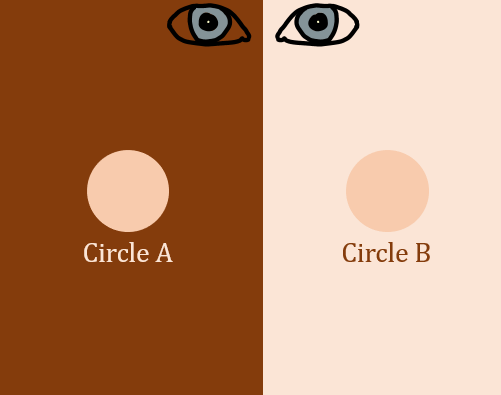The words covered in this article are subjective and objective, perception (along with perceive, misperception, percipient, and perceptive), imperceptible, digress and digression, contentious. Previously done words that will reoccur today are ambiguous, reverence, veneration, proscribe, proscription, idolatry and equivocal.
We talked yesterday about how the word ‘worship’ is ambiguous and can be interpreted in two ways – as either reverence or the stronger, deeper emotion of reverent love.
Now look at the painting below:

What are the man and the woman doing? They are worshipping the stone idol, yes, but what if I ask you to be more precise and to say whether the couple is only venerating the idol, or whether they are adoring the idol, showing reverent love for it?
If a roomful of people are asked this question, some may say – “they both look calm and are not showing much passion. So, the emotion seems to be lesser than reverent love; they seem to be only reverencing the idol.” But others may object to this view and say, “Not everyone shows love the same way. The calm prayer of this couple can as much be an expression of love as dramatic gestures like kissing the stone idol a hundred times. The couple may very well be adoring the idol.”
The correct answer to whether this couple is venerating the idol or adoring it can be given only by the couple themselves. Who are we to say what is actually going on in their heads in the moment shown in this painting? But if we are nevertheless pressed for an answer, then whether we see veneration in this painting or adoration depends on us; we may even see something entirely different in it. Therefore, what we see is subjective.
Subjective-Objective
The words subjective and objective are the opposites of one another.
Subjective means depending on a person’s feelings, thoughts or beliefs, and therefore, based on how reality is perceived rather than on objective reality.
Objective means independent of personal feelings or biases; based on facts, not on feelings.
Perception
To perceive something means to become aware of it through one of our five senses. For example, you may perceive the room getting colder or you may perceive the music in a bar getting louder.
The noun form of this word is perception, an awareness of something around you that you gain through your senses. What then would be a misperception? It would be a wrong awareness, a false information given to you by your senses.

Look at the image above. Do you see the circle B as darker than circle A? The truth is that both the circles are of the same color. So, Circle B’s relative darkness is a misperception. Circle B appears to be darker than circle A because it is contrasted with a lighter background.
Such contrast effect also causes misperceptions by our other senses. For example, if you put your left hand in cold water and right hand in hot water, and then put both hands in a tub of lukewarm water, your left hand will feel the water to be warmer than your right hand.
These examples show that our perceptions may sometimes be wrong.
Someone who is good at noticing and understanding things is said to be percipient or perceptive.
Imperceptible
What do you call something that cannot be sensed through your eyes, ears, nose, tongue or touch? This is a thing that cannot be perceived. So, it is imperceptible.
It’s time now for an interesting exercise. Watch this short video, titled ‘Movie Perception Test’ by Daniel Simmons:
How many editing mistakes did you perceive in the video? If you spotted even one, then you were more percipient than me!
But we have digressed!
Digress
To digress is to wander away from the main subject and start talking about something else.

We were talking about the ambiguous nature of the word ‘worship’ and the subjectivity of how one person’s act of worship may be interpreted by others, but we then got carried away into a discussion of perception and errors of perception. So, we digressed.
The noun form of this word is digression.
Let’s get back on track.
The point that I was making before our digression was that what the couple in the painting is actually feeling at the depicted moment is unknowable to us; we can only guess, and since your guess can be different from mine, what we see in this painting is subjective.
Idolatry is proscribed in Christianity. The first of the ten biblical commandments is as follows:
“You must not have any other god but me.
You must not make for yourself an idol of any kind or an image of anything in the heavens or on the earth or in the sea. You must not bow down to them or worship them, for I, the Lord your God, am a jealous God who will not tolerate your affection for any other gods.”
Exodus 20, New Living Translation
A devout Christian will probably see the above painting as a portrayal of idolatry because the couple is worshipping a stone god, a false god. But what if this painting had an icon of Jesus instead of the stone god? What would the devout Christian see then?
As it turns out, the answer would be subjective again – it would depend on what region and branch of Christianity this person came from.
Though idolatry is proscribed in Christianity, veneration of icons has been a part of Christian worship rituals right from the earliest centuries of the religion. For just as long, people and religious scholars have questioned whether such icon veneration violates the proscription on idolatry.
Contentious
The adjective contentious means that which causes argument. This word is also sometimes used for people. A contentious person is an argumentative person. The noun form of the word is contention, which means argument.

Icon veneration has been a contentious issue in Christendom. Some devout Christians – let’s call them icon haters – passionately believe that icon veneration violates the proscription on idolatry, while others – we’ll call them icon accepters – just as passionately believe that people who venerate icons do not adore them, and that therefore, icon veneration is not the same thing as idolatry.
We can also understand the contentions of (that is, the arguments made by) the two opposing camps in terms of the two definitions of the equivocal word ‘worship’:
- Reverence
- Reverent love and adoration
If ‘idolatry means the worship of idols (images)’, then:
- The icon haters apply both meanings of the word ‘worship’ to the definition of idolatry, and therefore, interpret the biblical proscription of idolatry to mean that one cannot show any reverence to images.
- On the other hand, the icon accepters believe that the word ‘worship’ should only be understood in the sense of ‘worship by adoration’, and so, to their minds, ‘icon veneration’ is excluded from the biblical proscription of idolatry and is okay to do.

As you can see, how these two groups interpret the proscription of idolatry is subjective. Both groups sincerely believe that they are right and argue hotly about the correctness of their own position.
Later this week, you will see an example of how much bitterness, violence, and division the question of icon veneration has caused in the Christian world. I’ll share the story of a well-meaning eighth century king who ordered the smashing of all icons of Jesus in his land and the killing of nuns. But to prepare for that article, we first need to talk about metaphors and analogies.
Before you go, I’ll love to share my favorite example of subjectivity – the cartoon below:

See you in Day 10!